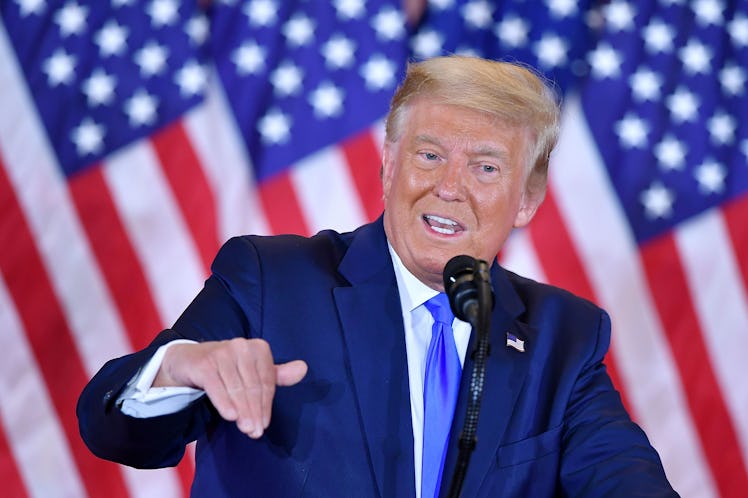
Trump Wants To Stop Counting Votes, But That’s Not How Elections Work
As expected, President Donald Trump concluded his election night festivities by prematurely claiming victory in the 2020 presidential race. In a speech during the early hours of Nov. 4, the president baselessly claimed the race had been marked by "major fraud" and that he'd be going to the Supreme Court to stop the counting of ballots after Election Day. So, can Trump stop mail-in votes from being counted? Barring a Supreme Court ruling, it's unlikely the president will be able to upend the ballot counting process.
Although Trump has claimed victory, as of 11 a.m. ET on Nov. 4, no news organizations have declared a winner in the presidential election. Still, Trump said in his Nov. 4 speech, "Frankly, we did win this election ... So our goal now is to ensure the integrity for the good of this nation. This is a very big moment. This is a major fraud on our nation. We want the law to be used in a proper manner. So we’ll be going to the U.S. Supreme Court. We want all voting to stop. We don’t want them to find any ballots at 4 o’clock in the morning and add them to the list." Elite Daily reached out to the Trump campaign for clarification on his comments and if the president was referring to stopping mail-in ballots in certain states, but did not hear back at the time of publication.
Biden campaign manager Jen O’Malley Dillon replied to Trump's comment on Nov. 4, calling his attempt to stop counting ballots "outrageous, unprecedented, and incorrect." She added, "The counting will not stop. It will continue until every duly cast vote is counted. Because that is what our laws — the laws that protect every Americans' constitutional right to vote — require."
Trump's threat of going to the Supreme Court, which is likely the only way he would be able to try to stop the counting of valid mail-in ballots, has yet to come to fruition as of 11 a.m. ET on Nov. 4, and mailed-in ballots are still being counted in states like Pennsylvania, Michigan, and Wisconsin, North Carolina, and Georgia. This may seem unusual, but every state typically keeps counting its ballots after Election Day, according to The New York Times. And with a record number of mailed in votes, the timing depends entirely on how fast states can count them.
Many states vary in if they count mail-in and early ballots before or after their Election Day ballots, and mail-in ballots are not sorted or reported according to county, which means mail-in ballots take longer to count. For battleground states like Pennsylvania and Wisconsin, they weren't able to start counting their mail-in ballots until Election Day, which makes it likely the public won't know the final results from these states for a few days. Additionally, the official certification state deadlines for ballots range from a few days to a few weeks after the election. States officially send their results to Congress on Dec. 23 this year.
On election night, major news outlets that are part of the National Election Pool shared projections based on precincts reporting, which are rough estimates based on partial counts. With the partisan divide of early and day-of voting, the estimates provided by precincts reporting were not as accurate as past years, creating a "red mirage" that appeared to have Trump winning.
Trump told supporters he was planning to take the matter to the Supreme Court when, after the "red mirage," many states began turning blue on the morning of Nov. 4, with the addition of mail-in ballots that were finally counted.
"Last night I was leading, often solidly, in many key States, in almost all instances Democrat run & controlled. Then, one by one, they started to magically disappear as surprise ballot dumps were counted," he tweeted on Nov. 4. "VERY STRANGE, and the 'pollsters' got it completely & historically wrong!" The tweet was later marked by Twitter as containing inaccurate or misleading information.
President Trump has not specified which states he'd file lawsuits against to stop the counting of mail-in ballots, although they're likely to be swing states like Pennsylvania. If the case winds up in the Supreme Court, the country will have to wait and see if the justices decide differently than when they decided not to rule in the case of a Pennsylvania Supreme Court ruling, which meant it didn't reverse a decision that allowed election officials to count ballots received until Friday, Nov. 6, so long as they had been postmarked by Nov. 3.
As long as the race remains too close to call with many mail-in ballots still needing to be counted, there remains a chance the election results will go to the Supreme Court. But it seems it would be a question of whether counted mail-in ballots are legitimate — which they should be if they were marked by Nov. 3 and received by the state's deadline — rather then forcing states to stop counting mail-in ballots altogether.